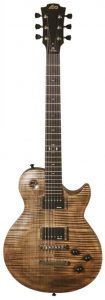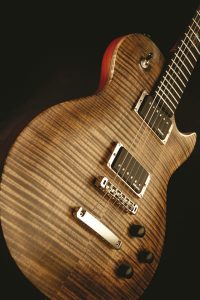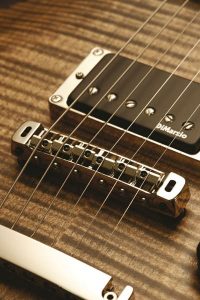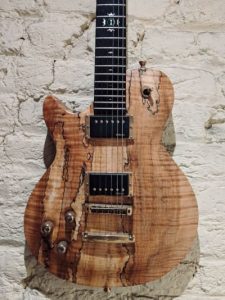Review
Table of Contents
Slim, sexy, resonant and beautifully designed, this handbuilt single-cut shows exactly the kind of quality that Lag Imperator i3000 handbuilt Master Series is capable of. Review by Huw Price
Lag, Lag Imperator i3000 Most of us are content to play classic-styled guitars, but some makers are prepared to innovate and experiment with new shapes and materials. This adventurous spirit has always been prevalent in Europe, maybe because our European colleagues are less enchanted by Anglo-American rock culture and all its accoutrements.
The French company Lag has been a case in point ever since former prog rocker Michel Chavarria started making guitars in the south of France in 1981. Like Paul Reed Smith and Bob Taylor, Chavarria has reverted from boardroom to bench to start making once again. His newly-assembled team hand-builds Lag’s new Master Series, and Chavarria signs off each and every instrument personally.
Lag Imperator i3000 is understated, but there’s a lot of detail when you get up close. The solid book-matched flame maple top has a flat surface for the pickups, tailpiece and bridge, then sweeps down to the unbound edges via recessed controls. The back is carved from a single piece of African mahogany with a slight rib contour, just 25mm thick to keep the weight down. We like the black/off-white/black striping all around the body where the front meets the back.
Lag Imperator i3000 Design
The three-piece African mahogany neck has a two-way truss rod and two titanium reinforcement strips. The glued-in neck joint sweeps up from the cutaway to the upper bout and the heel curves into the body, so you can reach the 22nd fret without the palm of your left hand even touching the guitar. It’s elegant, but though the guitar is covered in a slightly opaque satin polyurethane that’s thin and well-applied, the neck joint area seems to have been stained and the grain is rather obscured. This makes an otherwise crisp and tight joint look slightly sloppy.
The detailing everywhere else is of a much higher standard. The elegant headstock has a double layer of ebony veneer, creating a 3D effect that allows the trussrod cover to be inlaid flush with the surface. I’m a fan of Gotoh tuners, and this ebony-look set really looks the part. The fingerboard is African ebony with ebony edge binding and black pearl crown markers plus a circular motif at the 12th fret. It’s extremely well done, though the side dots look like plastic. The fret job is top drawer with a medium-gauge Dunlop wire that’s wide and not too high.
A huge amount of thought has gone into the styling,. From the black DiMarzios with surround-matching chrome screws to black knurled metal knobs. And wide strap buttons that accommodate the supplied strap-lock option. The Gotoh 510 hardware looks and feels substantial. With a bridge that connects to the body via two substantial bolts and a stop tailpiece that butts up against two small studs that are sunk deep into the body. Controls are pretty simple. With a master tone and individual volumes that double up as push/pull switches for coil tapping.
Sounds
Lag Imperator i3000 feels like a player’s guitar, with a soft, played-in vibe rather than the brutal precision of a dedicated shredder. The neck is a pleasant handful, and the flat 380mm fingerboard provides an intriguing classic/modern feel. The acoustic tone is excellent, with a resonant, freed-up quality that combines deep bass with thick woody lows and plenty of trebly sparkle.
With coil taps, you can go for high output humbuckers. The DiMarzio Tone Zone DP155 is wound hot, but Alnico V magnets keep things rock rather than metal. In double-coil mode this pickup will push any valve amp into thick, creamy overdrive with plenty of articulation. And fat bass and low mids for substLag, Imperator i3000antial power chords and single notes. It isn’t transparent, but if you like that throaty clean rock sound, it delivers.
The DiMarzio Virtual Hot PAF DP214 at the neck is Alnico V again, but it’s designed for a more even frequency balance. When pickups like this are paired up, traditional Rhythm/Treble settings don’t apply. The Lag’s neck pickup is as bright as the bridge, but it can’t compete for snarling aggression.
Lag Imperator i3000 Volume
At low volume both pickups sound slightly thin in coil tap mode, but they sound cool and funky together. The key is in exploring the different coil combinations and varying the balance with the volumes. Blending a smidge of coil-tapped neck into the ‘buckered bridge adds an airy sheen to the beefy rock tone that really enhances the tone. Shift the balance in favour of the neck and you get a convincing Fender-type response with bolstered midrange. The possibilities are endless and since both volume controls have treble bleed caps, things stay clear when you turn down.
This guitar really comes to life when you turn up because the pickups feed on high gain. And contrary to expectations this is the zone where the electronics and the wood combine to best effect. The bridge is pretty rude, allowing brutal chord chugs and pinched harmonics to leap out effortlessly. The neck has a bluesier, more vocal tone, but it stays composed in the low end regardless of filth levels. Best of all the sustain is amazing, but I’d say it’s the dynamic response that sets this guitar apart.
Verdict
Tremendous natural resonance, high quality materials, easy playability and well-considered controls combine to make the Lag Imperator i3000 a serious contender for modern rock players as well as more adventurous roots rockers. No doubt, this is powerful stuff.





Leave a Reply
You must be logged in to post a comment.